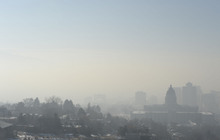This is an archived article that was published on sltrib.com in 2014, and information in the article may be outdated. It is provided only for personal research purposes and may not be reprinted.
Among the many hotly debated issues regarding Utah's air quality: Where does the pollution come from?
A group of physicians concerned about health effects of air pollution will take up the question in a public discussion Thursday starting at 7 p.m. at Salt Lake City Main Library auditorium.
Views differ on which and how much of the emissions in the Wasatch Front's inversion come from major industrial polluters, more widespread emitters such as commercial buildings and homes, and the exact role of millions of automobiles.
Differences of opinion are especially sharp over PM2.5, a fine particulate pollution that has emerged as a major target of recent study and policy-making.
Air-quality activists — including Utah Physicians for a Healthy Environment, which is sponsoring Thursday's discussion— dispute numbers published by state regulators on the share of emissions linked to industries such as smelters and refineries. In one recent report, for example, state regulators attributed about 11 percent of Salt Lake County's PM2.5 to industry.
Brian Moench, president of Utah Physicians for a Healthy Environment, said those numbers mislead the public by down-playing industry's role while also glossing over effects of other toxic emissions, including health-damaging heavy metals.
Those pollutants, he said, ``are a major issue not getting media attention.''
Officials with the Utah Division of Air Quality defend their analysis of sources of PM2.5 and other air pollutants, including heavy metals. Their numbers reflect deep analysis, DAQ officials say, and can vary widely depending on the region studied, the time of year and how pollutants are defined.
``It sounds like a simple question,'' said Bryce Bird, director of Utah DAQ, ``but it's a complex answer.''
Regulators focus heavily on controlling industrial pollution, Bird said, but are also interested in changing public perceptions on the critical role of reducing emissions from car tailpipes, estimated as the source of half of emissions that make up PM2.5.
Entitled, "Smoke and Mirrors: Fact vs. Fiction about Utah's Air Pollution," Thursday's discussion is free and open to the public. It also will be broadcast live by KCPW, on the radio at 88.3 FM and 105.3 FM, and online at the station's website, KCPW.org. —
Public discussion about bad air
"Smoke and Mirrors: Fact Vs Fiction about Utah's Air Pollution," a public discussion about Utah's air pollution problem, takes places starting at 7 p.m. Thursday at the Salt Lake City Main Library, 210 E. 400 South, Salt Lake City. The discussion also will be broadcast live on KCPW 88.3/105.3 FM.



